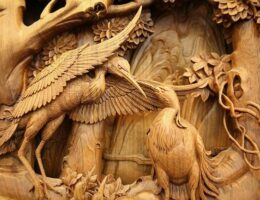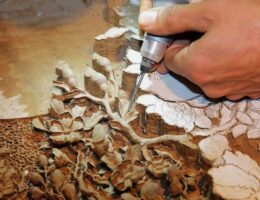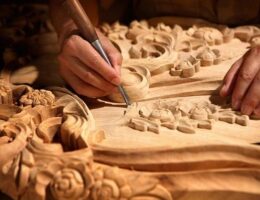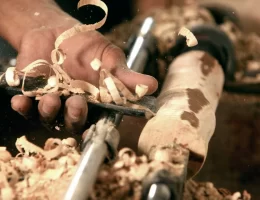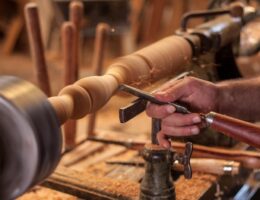IRAN ART EXHIBITION: MONABAT-KARI OR WOOD CARVING IS INDEED UNIQUE
Wood carving is as old as humanity. Throughout the course of history, all of the ancient civilizations have left a unique impact on the art of carving wood by bringing life to their most sacred dreams, ideas, and inspirations.
Little by little, century by century, the secrets of working with wood were passed from one skillful woodcarver to another. And indeed, every woodcarver is influenced by the wave of the particular century he lived in.
Thus, historical events are the cornerstone to the art of woodcarving. It’s as if you can see through the veil of time while gazing at the magnificent woodcarving artwork of each nation. Iran is no exception.
But where does the Persian trace in the art of Monabat Kari merge with the Iranian trace? What are the secrets of the gifted woodcarvers? Read on and experience the one-of-a-kind beauty of Monabat Kari.
Monabat Kari: Looking Behind the Curtains of an Ancient Legacy
Unfortunately, the very mention of Iran seems to bring many negative associations to most of the people who are part of Western society.
While the truth is, our world is undergoing a silent crisis, a torturing depression marked by the hands of war despite the fact that we are living in the 21st century.
However, tourists who visit Iran share that the atmosphere in the country is shaped by an undisputable, hard-to-see-elsewhere hospitality. As you roam the streets of Iran, it’s as if you slowly sink into another dimension.
The history of the country speaks behind every corner, as the scenery is shifting from eye-alluring old buildings through colorful streets where art winks at you in various forms.
Monabat Kari is translated as Iranian wood carving.
The Persian Trace in the Art of Monabat Kari
The mention of Persia brings a sense of mystery, which is so vast, and so unknown, that it seems as if Persia is a long-gone legend.
Surprisingly, the Persians who used to live within what we nowadays call Iran have long been calling their country with the name Iran. Yes, Iran and Persia are interconnected very deeply and intricately.
IRAN ART EXHIBITION: In fact, Persia is simply how Westerners kept referring to the lands of Iran, as well as a huge part of the surrounding lands. But by 1935, things changed with the name Iran stepping onto the international stage. Initially, it was in 1979 when Iran officially announced itself as separate from the vast and ancient term Persia; it was then that the Islamic Republic Government was put into place.
When it comes to the intertwined culture of ancient Persia and modern Iran, the art of woodcarving – Monabat Kari – can serve much like a time machine.
The Multiple Layers of Monabat Kari
The meticulous, handcrafted objects made out of wood and decorated with absolute perfection to the detail speak of legends, myths, fairy tales, history, beliefs, traditions, and something more – real feelings and creativeness.
For instance, getting to know more about the Iranian culture which has such a rich history is a feeling you can’t put into words. In fact, getting to know more about the unique traditions of any nation is a sublime momentum of expanding our awareness of the world we inhabit.
Fortunately, one thing remains sacred and unspoiled by global government conflicts, and this is art. Art has many faces. But above all, it always makes you feel.
What do you feel when looking at the detailed, delicate carvings which are typical for the masters of wood carving in Iran? Can you feel the influence brought by their ancestors – the mighty, artistic and crafty Persians?
The Imprint of Persian Fairytales and Mythology in Monabat Kari
Apart from historically important figures and events, as well as the naturally occurring phenomenon, flora, and fauna, birds have a highly symbolic meaning in the art of Monabat Kari.
Interestingly, it is the mythical bird called Simorḡ (also pronounced as Simorgh), which is one of the most well-known symbols of the traditional Iranian legends.
The Simorḡ bird was believed to sit on the Tree of healing. Simorḡ is said to shake the branches of the Tree of healing so that seeds would scatter and, initially, fertilize the Hungry Earth.
In one of the most famous Persian fairy tales Simorgh helps Prince Khorshid to return back to his kingdom after being betrayed by his own brothers.
Simorogh gave the prince 3 of her precious feathers, telling him to burn one of them whenever he needs Her divine help.
Every Persian fairytale begins with the words “There were being and nonbeing, there was none but God.”
IRAN ART EXHIBITION: The interconnection of Light and Darkness is fundamental to the way Iranians perceive the world. Light is a symbol of consciousness and the essence of life, while Darkness symbolizes all things which have a particular form, as the form is considered as non-life.
Above all, it’s illuminating to see how the beliefs of each nation intertwine, keeping in mind that Asians embrace the philosophy of Yin and Yang – the Light and the Dark, the Good and the Bad, which marks basic principles of the Universe.
Certainly, the best way to understand and feel the ancient beauty and wisdom of Monabat Kari is by exploring the genuine perspective of a native woodcarver.
The Secrets of Monabat Kari: What are the Tools Used for the Creation of Stunning Hand Carved Masterpieces
Iranians consider wood carving as one of the national arts and handicrafts, which have not only withstood the test of time but have also evolved into a flourishing business for the skillful woodcarvers.
The major rule in the art of Monabat Kari is that only simple tools are used in order to shape the wood into intricate shapes and patterns.
Interestingly, according to the way Iranians perceive the secrets of wood carving, the most important tool in Monabat Kari is the wood itself. This is more than just logical to assume since the wood needs to combine 2 opposite features – it has to be strong and durable but simultaneously easy to cut and smoothen.
It is exactly because of the absence of any advanced equipment that the art of woodcarving becomes so highly valued; the woodcarver must possess a deeply embedded feeling of harmony, beauty, and creativity.
Meanwhile, he should be able to work with a light hand and extremely precise moves. Finally, the more complex the wood carving, the higher the value of the woodcarver’s work, which takes hours, weeks, and sometimes even months to accomplish.
To summarize, Iranians look up to woodcarvers as artists who are extremely gifted and talented.
What is the Best Type of Wood Used in Monabat Kari?
As mentioned above, woodcarving requires a very specific type of wood which will provide the much-needed strength of the material along with a particular ease of smoothing, cutting, and shaping it into particular shapes.
For this purpose, Iranians believe that the best wood for woodcarving comes from Walnut and Pear trees.
In fact, walnut farming has a rich history. For instance, the city of Tuyserkan, which is located in Western Iran, is known as the Walnut city.
Thus, September is marked with the celebrations of harvesting the highest-quality walnuts. During this very special time of the year, more than 30 thousand farmers take part in hand picking the walnuts.
But what’s more, the abundance of walnut wood has stimulated the national woodcarving industry in Iran tremendously. According to the reports from 2017, there are over 4000 small businesses in the region of Tuyserkan alone, who are making a living through woodcarving.
Furthermore, this makes approximately 8000 woodcarvers in this area who are practicing the old principles of Monabat Kari, slowly but surely bringing Iran worldwide acknowledgment, and supporting the flourish and preservation of the woodcarving crafts.
IRAN ART EXHIBITION: As a result, a special woodcarving festival is held to showcase the intricate mastery of Monabat Kari, as well as to exhibit the numerous wood-carved masterpieces of the native artists and craftsmen.
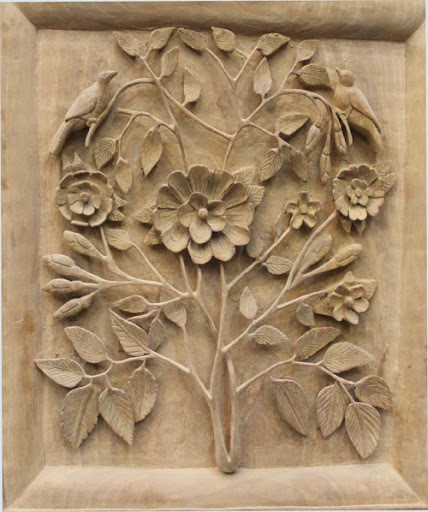
What is Khatam Kari?
Speaking about the spectacular art of Monabat Kari, it’s impossible not to mention another form of ancient form of Iranian woodworking which has gained world acknowledgment – Khatam Kari.
Khatam Kari (also referred to as Khatamkari) is the native Iranian art of inlaying the surface of precisely geometrically shaped wood articles with delicate pieces of bone (such as ebony), and precious metals.
The mission of the Khatamkar (the Khatamkari maker) is not an easy one. Much like with wood carving, the art of Khatamkari requires a very specific set of skills, which can take years to master. Of course, that’s possible only in the case the Khatamkar is naturally gifted.
The best way to delve deep into the secrets of any national art or craft is hidden in the very roots of the word national. Because if there’s someone who can make you truly feel the essence of Monabat Kari, that’s undoubtedly a native woodcarver. Mr. Mohammad Mohammadzadeh comes from a family of wood carpenters. He started working with wood very early; in fact, earlier than when most kids even get to fully master speaking fluently, being only 4-5 years old.
Up-to-date, Mr. Mohammad Mohammadzadeh has got to know wood so well that he can tell the age of the wood material, as well as what he can possibly do with the particular wood at a mere glance.
One of the basic principles of woodcarving he follows is that no material is allowed to be wasted, even if it comes to millimeters of wood. Nonetheless, he uses old designs in many of his wood sculptures, doors, vases, or frames, keeping the unique imprint of history as part of his work. He also shares that books are one of the main sources of inspiration for his crafts.
Interestingly, Mr. Mohammad Mohammadzadeh doesn’t limit to working only with Iranian wood. Instead, he works with wood from all over the world. However, he also uses only all natural materials such as special plant-based dyes. The beautiful story of Mr. Mohammad Mohammadzadeh is soaked with the spirit of a passionate woodcarver. He says that once he is finished working on a particular design, he instantly wants to make something better, to keep improving his techniques. What’s more, the way he looks at the tress is unique. Mr. Mohammadzadeh believes that trees are full of knowledge.
He uses an incredible parallel to compare the value of trees to the value of building a factory as big as Tehran, pointing out to the fact that even the best factory can not possibly give you what a tree has to offer: delicious fruits.
For wood artists like Mr. Mohammad Mohammadzadeh, wood is not something separate from his Self; he sums up his beliefs beautifully by stating “I am from wood and wood is from me.”
Final Food for Thought
IRAN ART EXHIBITION: The art of Monabat Kari carries the ancient wisdom of woodcarving throughout the centuries. Wood has always been of assistance to humanity. But what’s more, wood is present in the history of humankind as something much more valuable than merely a practical material.
Fire would be impossible without wood, and the wood itself is a renewable source, which only makes it even more meaningful and important to society nowadays.
Working with wood has and will keep to sparkling the vital flame of creativity, which is so necessary in order to nurture the most sacred part of being a human: the Soul. And indeed, wood speaks an international language all Souls can understand, for it takes no translation, and neither are there any limits to admiring what the human hand is possible to achieve in the gentle embrace of Mother Nature. The extraordinary love and talent behind Monabat Kari can be summed up with one of the unforgettable quotes by the ancient Persian poet Rumi.
“I belong to no religion. My religion is love. Every heart is my temple.”

History of wood carving in the world
Thousands of years ago, ordinary people used wood as a cheap and available raw material, so there is no accurate estimate of the history of wood carving in Iran and the world. On the other hand, the durability of wood against natural factors is not very high and due to heat, moisture, and other natural factors, it is subject to change and erosion, so there is no trace of old wood carving works. The oldest known inlay is a wooden statue discovered in Egypt dating to 2,500 BC. Of course, the 11,000-year-old Shigir idol wooden statue can be considered the oldest wood carving work.
History of wood carving in Iran in the different periods
The art of wood carving in Iran has a long history and dates back to the arrival of the Arabs about 1,500 years ago. The oldest inlaid work in Iran is a wooden door belonging to the Old Mosque of Shiraz. This door, which belongs to the third century AH, is about 1,200 years old. The culmination of Iranian inlaid art was during the Safavid period and declined in the late Zandi and early Qajar periods. Today, the profession of wood carving, like other Iranian handicrafts, is well-established in all parts of the country and is especially flourishing in cities such as Golpayegan and Abadeh.
Among the cities of Iran, Isfahan’s carvings are known to the world more than other regions of the country due to the movement of foreign tourists and buildings left over from the past. The wooden roof of the Hasht Behesht Mansion is one of the examples of Isfahan’s wood carving that has attracted the attention of many foreign visitors. Since the rise of the Seljuks, the use of wood has gradually changed shape, and wood carving has become commonplace. Unfortunately, there are not many examples of the wood industry in this period. But two pieces from the construction of the 12th century, about the end of the Seljuk period, are kept in the museum, which shows. Decorating wood carving with flowers and embossed plants is common today. The works of the wood carving industry are relatively more in the period of Genghis and Timur, and there are many Iranian motifs and Chinese designs. Also named the shrine of Hazrat Abdul Azim in the city of Rey.
The Timurid period
IRAN ART EXHIBITION: During the Timurid era, the Mongol wood carving continued. One of the best examples of this period is the two doors of the second half of the 15th century (9th century AH), which are kept in the Metropolitan Museum. These two-door leaflets are divided into square pieces, and inside each of them, there are other divisions, and its decorations are geometric patterns and delicate leaves, which were usually used by the goldsmiths of the Timurid period.
Zandieh and Qajar periods
During the Zandi and Qajar periods, wood carving declined, and the construction of inlaid doors and large pieces gave way to smaller pieces such as the recitation of the Qur’an and the mirror frame.
In general, there are no credible artifacts from the past, and the reason for this can be the short life of wood that gradually disappears, as well as the lack of proper maintenance of wooden items due to lack of materials and protective equipment such as varnishes and paints used today.
However, there are relatively old traces of wood carving in our country. Which are mostly done on the doors of tombs, mosques, and the reason for their survival is due to the religious respect of people for these places. Some of which are up to 1000 years old. Currently, wood carving is common in all parts of Iran. It can be said that in the cities of Tehran, Isfahan, Shiraz, Abadeh, Shahroud, etc., relatively more wood carving is done.


